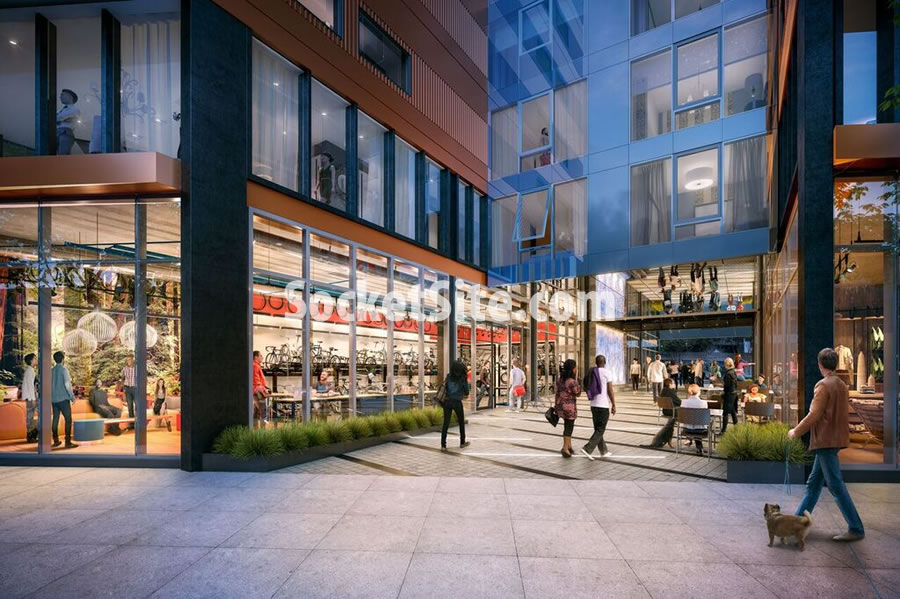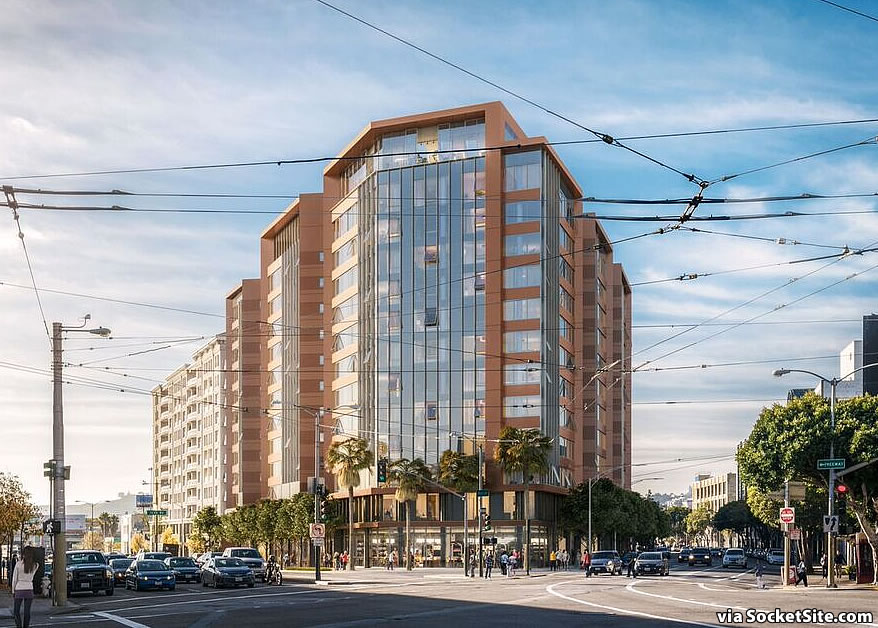As we revealed last week, the proposed 220-unit building to rise up to 12 stories upon the Tower Car Wash site includes a mid-block pedestrian alley between Mission Street and South Van Ness Avenue.
The alley would provide access to 1601 Mission Street’s lobby, a “lounge” for 71 bikes and their riders, and a few of the development’s retail spaces:


Looks great!!! Get this aporoved
Attractive feature.
This area needs all the help it can gets. A nice tree lined median along South Van Ness would be great.
From Market to Mission there’ll instead be BRT. South of that a landscaped median could be possible.
Wind is a huge factor in lack of greening in this city, especially in this area.
I do not care for the overall massing and facade treatment: Miami-contemporary-Howard Rourak (Fountainhead)-Pruitt-Igoe comes to mind. It’s too massive, bulky, & cold; probably not going to age well either, unless it’s clad in stellar wrapping.
Pruitt-Igoe? Seriously? A development that holds the street (actually creates a streetwall)?
I don’t mind so much that it virtually fills the parcel, but it strikes me as bulky, plain-for-it’s-size (but not plain in a sexy, well-proportioned way), & monolithic. Maybe it looked great in the elevations but not in 3D. Maybe you could explain it’s aesthetic appeal. I don’t see it.
This stretch is not really that ped friendly given the street grid and number of traffic lanes in each direction. Not sure that may people other than tenants will service the onsite retail, and, of course, I don’t need to go into how wonderful SF alleyways are.
It’s true. SF alleyways are wonderful.
The block that Planning is on is probably the worst pedestrian block in the city. Coming down Gough to Otis, you have to walk ALL THE WAY AROUND to get to Mission. Most people just walk (illegally) through the parking garage.
Its ironic that while the Supreme Court is forcing Jerry Brown to release prisoners due to the deleterious effects of over-crowding, the city of San Francisco cheerily sells its future to overseas ill-gotten-gains money parking thugs jamming lowest common denominator towers into every available slot. Cause you know, over crowding isn’t deleterious when you have a “bike lounge.” What a load.
This is a city – always has been. You can still live in the richmond, marina, or noe if you don’t want capitalist bike lounges or ‘overcrowding’. Better yet, move to Albuquerque. Lots of parking. Very ‘livable’.
People need a place to live. The rent is to damn high!
Let’s be more specific: people who can afford market rate condos need a place to live. “If you can’t afford to live here then live elsewhere,” according to our dear friend Futurist.
Thanks for quoting me. And yes, we all make choices.
In addition, some choices are made for us.
I’m sure Futurist has worked hard to achieve owning his home in the extremely desirable Noe Valley neighborhood of San Francisco.
Unless you reside in a market rate apartment or condo, surely you are living in a rent-controlled unit?
This would make you one of the “haves” versus those forced to pay market rates, or move to a less expensive area outside of the City.
1. Yes I have.
2. Many others have.
3. Explain who is “forcing” you to pay market rates.
Footnote: You would do well to stop playing the “victim” and offer valid solutions as to how to make this city more “affordable” for people like you. Full disclosure: I don’t have a solution.
Thanks, Futurist, for admitting that you don’t have a solution (not that it wasn’t already transparent). However, based on your hundreds of comments on this site it’s rather glaring that you really don’t care about finding a solution to a problem that you admit does not exist.
The fact that our real estate market is the healthiest in the country and that our property values are increasing is obviously a wonderful development. If you want to live in a place with cheap housing, I suggest moving to Flint, MI.
Accra has some real bargains
You should be seriously putting your energy and anger towards the car break in epedimic that shot up over 30% YOY, or the homeless disaster that is the worst in the developed world. Housing is not the problem here.
Actually, housing is a chronic problem here, among the ones you pointed out.
No. Housing, in itself, is NOT a problem here.
Housing that is “affordable” to those with lower or modest incomes, yes, is a problem here for those who choose to live here.
For others it’s not a problem. So what really do you see as the problem?
You had me at caps lock, Futurist.
How so dearest soccermom?
Actually, I do have one solution that for some “might” make SF affordable to them: let’s increase salaries for good people like teachers, firemen and policemen/women. Not sure where the money would come from, but that would help them.
Now, to follow that, should we also increase the pay (a lot) for such good people as the barista at Spikes, the clerk at Cliffs, the bartender at Badlands, and the wait person at Catch? How much, how do we pay for it and will it really help them?
Should we continue to vilify others like myself who are homeowners? (BTW, I’m not hurt) I suspect many come here to comment and listen. Should we vilify others who are multiple property owners here, who have worked hard and been successful to buy real estate?
And furthermore, just building up and up and up (which we could do) will not make SF more affordable. Those developer/owners will want and expect market rate for their new housing units. And they should.
For “others” it is also a problem. It’s a supply and demand issue even for those at the top of the economic food chain who “choose” to live here. You’re completely wrong on this one, Futurist.
How am I wrong Mark? I’m interested in your take.
agree, the homeless and the crime rate is a much worse problem. we are trying to catch up with housing, but the bigger “housing” problem was the fault of newsom, slick willie , agnos, and everyone who refused to build before Lee got in office. they should’ve allowed 5000+ units/yr to be built all throughout 90s and 2000s. now, there is an affordability problem, but it is has more to do with wages and equity events than with housing
Don’t forget “the Market” as blameworthy for lengthy periods of failure to address Society’s housing needs.
the market was highly regulated by planning and local govt. the market wouldve produced enough units with less regulation
The “alley” is a planning code requirement, right? The developer needs to break down the facade because the site is longer than 400 FT.
Too small
This transit rich site should have more density